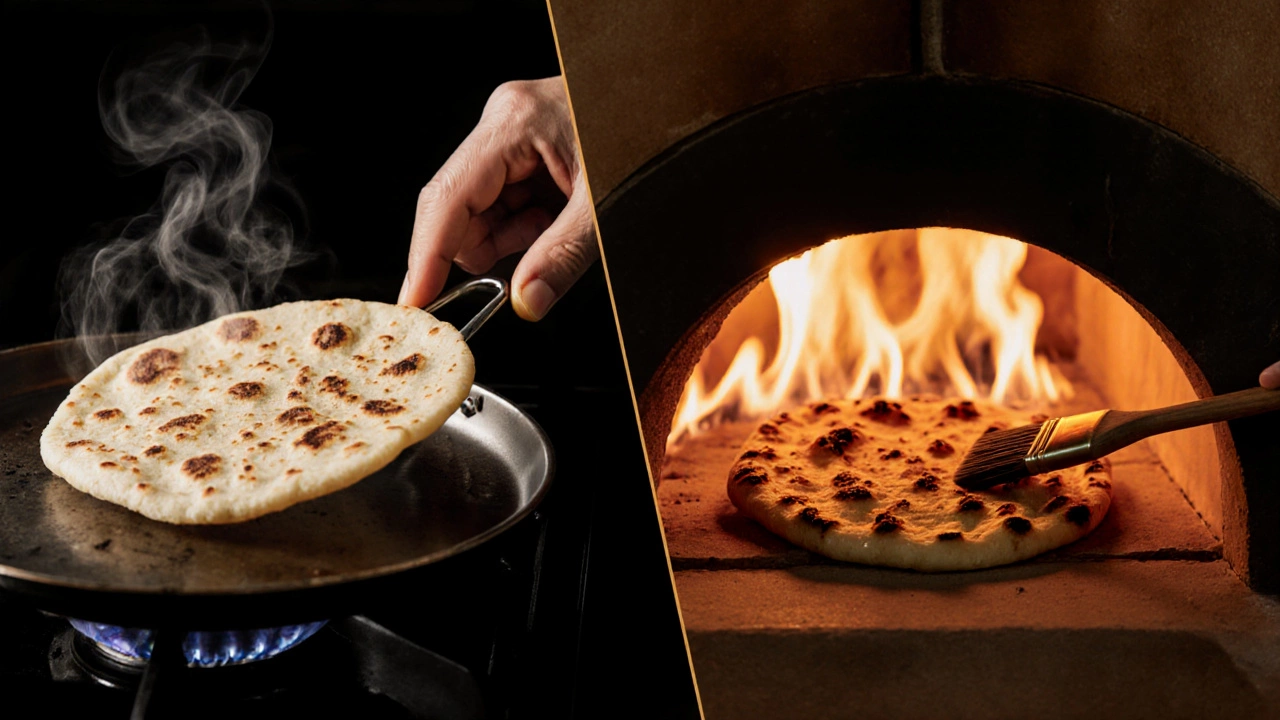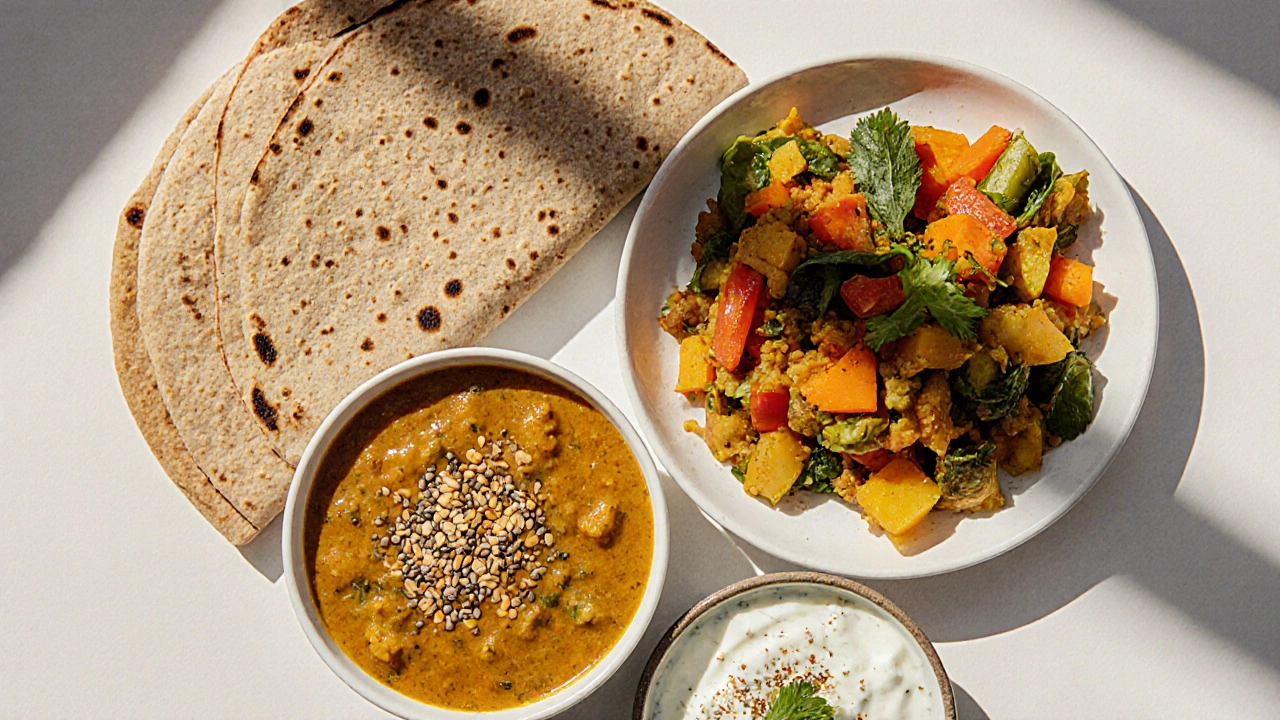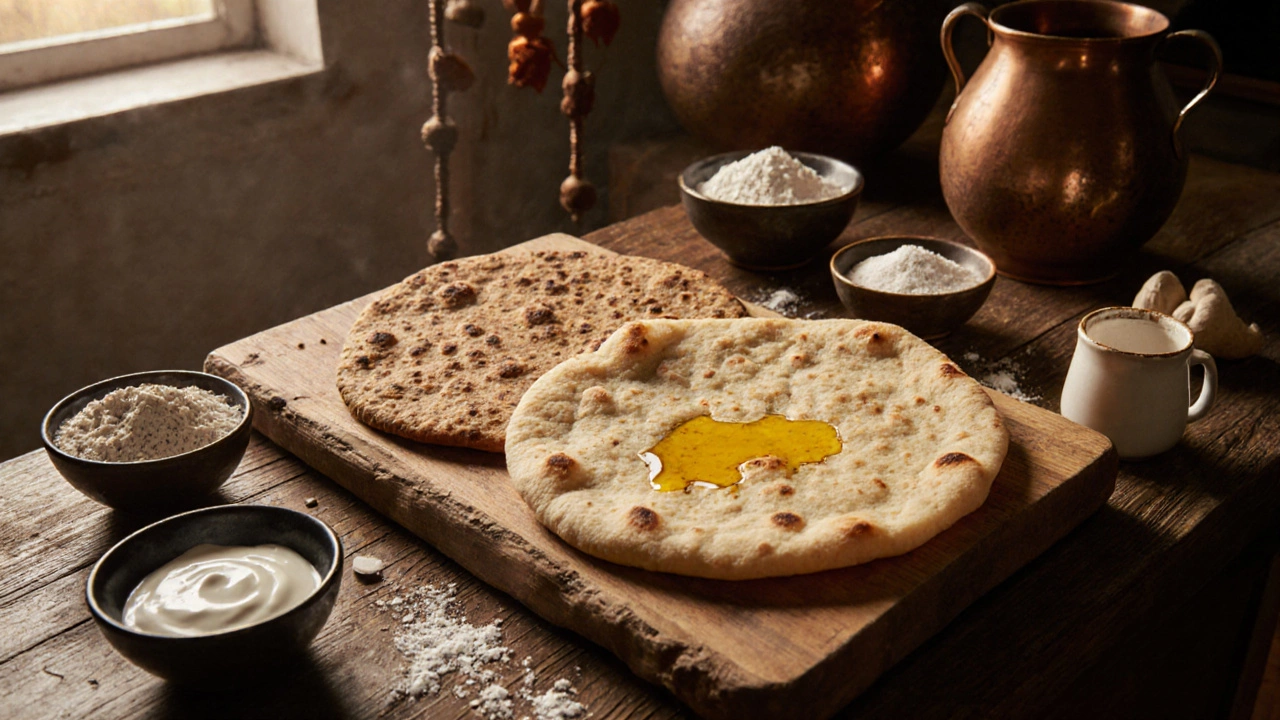19 Oct 2025
- 0 Comments
Roti vs Naan Nutrition Calculator
Select Serving Size
Choose Your Bread
Ever wondered whether roti vs naan is the better choice for a fit lifestyle? Both are Indian flatbreads, but they differ in ingredients, cooking methods, and nutrition. Let’s break it down so you can decide which one fits your health goals.
Key Takeaways
- Roti is usually made with whole‑grain flour, giving it more fiber and fewer calories.
- Naan often uses refined flour, yogurt or milk, and butter/ghee, which boosts fat and calorie counts.
- Both breads can be part of a balanced diet if you watch portion size and choose smarter toppings.
- Cooking method matters: tawa‑cooked roti stays lighter, while tandoor‑baked naan can pick up extra oil.
- Small tweaks-using whole‑wheat naan, less ghee, or adding seeds-can improve the health profile of either bread.
What Are Roti and Naan?
Roti is a thin, unleavened flatbread traditionally made from whole‑wheat flour (atta), water, and a pinch of salt. It’s rolled out by hand and cooked on a hot dry skillet called a tawa. Roti’s simplicity keeps it low‑fat and high‑fiber when made with whole‑grain flour.
Naan is a leavened bread that typically uses refined white flour (maida), yeast or baking powder, yogurt or milk, and often a drizzle of ghee or butter before baking. Traditionally it’s slapped onto the walls of a clay oven called a tandoor, which gives it a soft, chewy texture and characteristic char marks. The added dairy and fats make naan richer but also more calorie‑dense.
Ingredients and Preparation Differences
Understanding the ingredient list helps explain the nutritional gap.
- Whole wheat flour (atta) retains the bran and germ, supplying more fiber, protein, and micronutrients than refined flour.
- Refined flour (maida) is milled to remove the bran, reducing fiber and vitamins while increasing the glycemic load.
- Ghee adds saturated fat and calories; a tablespoon contributes about 120 kcal and 13 g of fat.
- Yogurt or milk in naan provides some protein and calcium, but also adds lactose sugars.
- Roti dough usually needs only water and salt, while naan dough requires a leavening agent and a resting time for fermentation.
Cooking methods also matter. A tawa‑cooked roti gets a light, dry surface; a tandoor‑baked naan often gets brushed with melted ghee after baking, boosting its fat content.
Nutrition at a Glance
| Metric | Roti (whole‑wheat) | Naan (white‑flour, with ghee) |
|---|---|---|
| Calories | 120 kcal | 210 kcal |
| Carbohydrates | 22 g | 30 g |
| Protein | 4 g | 5 g |
| Fat | 1 g | 9 g |
| Fiber | 3 g | 1 g |
| Glycemic Index | 58 (moderate) | 75 (high) |
Numbers can vary with size, thickness, and added toppings, but the trend stays the same: roti is lighter, higher in fiber, and has a lower glycemic impact, while naan packs more calories and fat.

Health Impacts of Each Bread
Calorie density directly influences weight management. If you’re watching your waistline, swapping a 210 kcal naan for a 120 kcal roti saves 90 calories per serving-roughly the amount you’d burn walking a mile.
Fiber, measured in grams, helps control blood sugar spikes and supports gut health. Whole‑wheat roti delivers about 3 g of fiber per piece, whereas naan often provides less than 1 g. This difference can affect satiety; you’ll feel fuller longer with roti, reducing the urge to snack.
The higher glycemic index of naan (≈75) means it raises blood glucose faster than roti (≈58). For diabetics or anyone looking to stabilize energy levels, roti is the safer bet.
For heart health, the saturated fat from ghee in naan is a consideration. Moderate intake is okay, but frequent consumption can raise LDL cholesterol. If you replace the ghee brush with a light olive‑oil drizzle, the fat profile improves without sacrificing flavor.
Making Roti Healthier
- Use 100 % whole‑grain flour or even a mix of millet flours for extra nutrients.
- Add a tablespoon of ground flaxseed or chia seeds to boost omega‑3s and fiber.
- Cook on a non‑stick tawa with a few drops of oil instead of butter.
- Serve with protein‑rich curries (dal, chickpeas) to create a balanced plate.
These tweaks keep the calorie count near 120 kcal while enhancing micronutrients.
Making Naan Healthier
- Swap half the white flour for whole‑wheat flour; you’ll retain the soft texture but add fiber.
- Replace yogurt with low‑fat Greek yogurt to keep protein high and fat low.
- Skip the final ghee brush or use just a teaspoon of olive oil.
- Incorporate herbs (coriander, mint) or spices (cumin) for flavor without extra calories.
With these changes, a naan slice can drop to around 150 kcal and half the fat.

When to Choose Which?
- Weight loss or maintenance: Reach for roti, especially with whole‑wheat flour.
- High‑energy needs (athletes, heavy work): A modest portion of naan provides quick carbs and extra protein from dairy.
- Digestive health: Fiber‑rich roti supports regularity.
- Special occasions: Naan’s soft, buttery feel makes it a festive favorite; just keep the serving size reasonable.
Quick Recipe Variations
Below are two simple recipes you can whip up in under 30 minutes.
Whole‑Wheat Roti (4 servings)
- Combine 2 cups whole‑wheat flour, ½ tsp salt, and ¾ cup warm water.
- Knead into a smooth ball; rest 10 minutes.
- Divide into 8 balls, roll each into a 6‑inch circle.
- Heat a dry tawa; cook each side until light brown spots appear (≈45 seconds per side).
Lighter Naan (2 servings)
- Mix 1 cup whole‑wheat flour, ½ cup white flour, ½ tsp yeast, ¼ tsp baking powder, ¼ tsp salt.
- Add ¼ cup low‑fat Greek yogurt and ¼ cup water; stir into a sticky dough.
- Let rise 45 minutes.
- Shape into oval discs, brush lightly with 1 tsp olive oil.
- Bake in a pre‑heated oven at 250 °C (or on a tandoor) for 2‑3 minutes until puffed and golden.
Serve either with dal, grilled vegetables, or a fresh cucumber raita.
Frequently Asked Questions
Is roti always healthier than naan?
Usually, yes-because roti is made with whole‑grain flour and rarely contains added fats. However, a whole‑wheat naan that’s brushed lightly with oil can be comparable. The key is looking at ingredients and portion size.
Can I freeze roti or naan for later?
Yes. Cool the breads, wrap each piece in foil or a zip‑lock bag, and freeze up to two months. Reheat on a hot tawa or in a microwave wrapped in a damp towel.
What’s the best pairing to balance the carbs?
Pair with protein‑rich dishes-lentils, chickpeas, paneer, or lean meat. Adding a side of colorful veggies adds fiber and slows sugar absorption.
Does the tandoor make naan less healthy?
The high heat itself isn’t an issue; it’s the post‑baking brush of ghee or butter that adds calories. Skip the brush or use a thin layer of olive oil for a lighter result.
Can I use alternative flours for roti?
Absolutely. Buckwheat, sorghum, or a mix of chickpea flour works well. Expect a denser texture and adjust water accordingly.
Bottom line: roti generally wins the health showdown, but a smartly crafted naan can hold its own. Choose based on your daily goals, adjust the recipe, and enjoy the delicious taste of Indian flatbreads without guilt.
